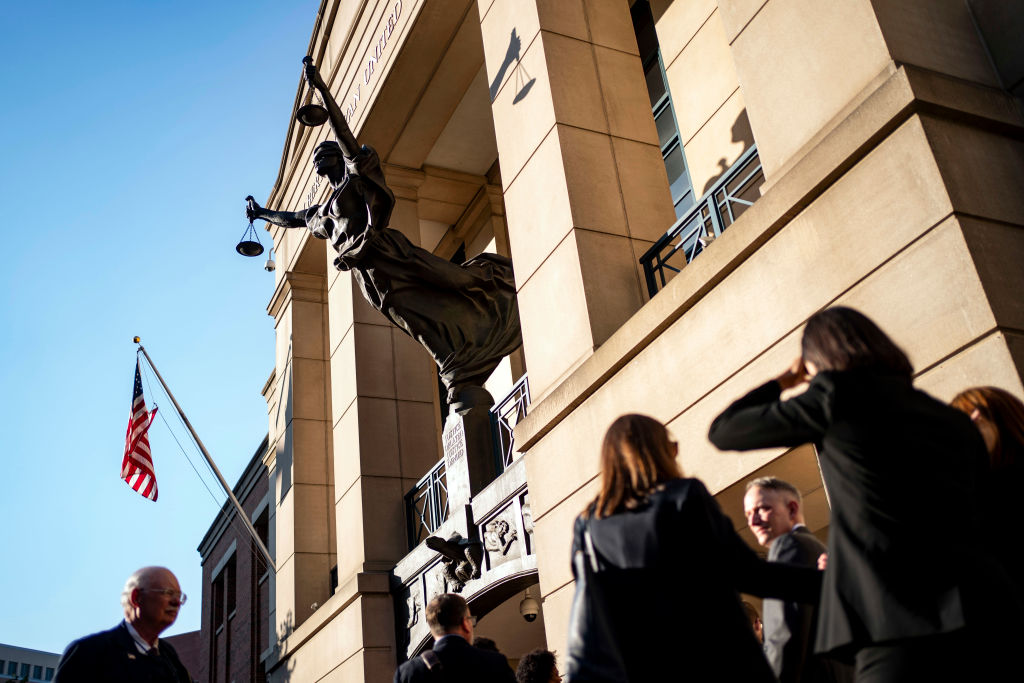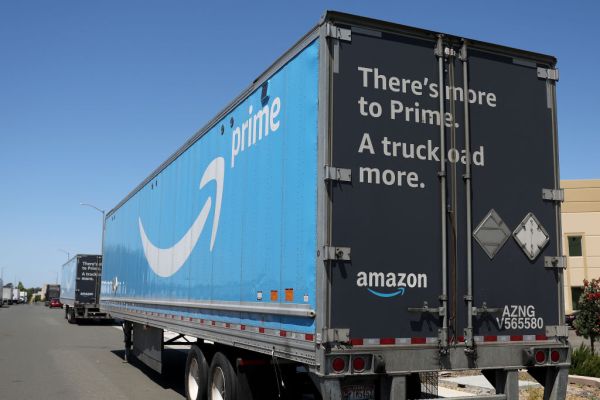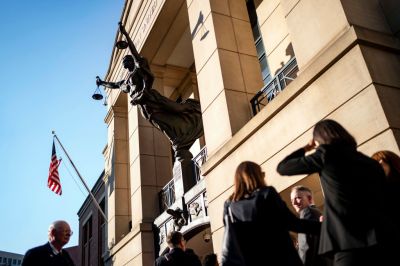Last week, Google concluded its defense in United States v. Google LLC, a case brought by the Justice Department accusing the tech giant of antitrust violations in its online advertising business, which accounted for $237 billion of the company’s 2023 revenue of $307 billion. The parties will now file written summaries of the key facts in the case and present closing arguments in late November.
The three-week trial, which took place in a federal courthouse in Alexandria, Virginia, is part of a broader antitrust crackdown on Google’s business practices. In August, a federal judge in Washington, D.C., ruled that Google’s search business violated federal antitrust laws in a lawsuit initiated by the Trump administration’s Justice Department. Last year, Google was found to have unlawfully monopolized its Play Store app marketplace in a suit brought by Epic Games, the maker of the popular video game Fortnite. (On Monday Epic sued Google and Samsung on related antitrust violations.)
After closing arguments, Judge Leonie Brinkema will make a ruling likely after several weeks or months. What comes next could result in big changes for Google that could affect the online ad industry at large.
How does the online ad industry work?
In the online advertising ecosystem, advertisers pay to display their promotional content, while publishers—such as mobile apps, search engines, and other websites—get paid to host these ads on their digital properties. While some advertisers and publishers work together directly, many online ad transactions occur through a complex, indirect auction system.
On the buy-side, advertisers typically manage their ads through advertiser networks. These networks aggregate ad inventory from multiple advertisers, allowing for more efficient distribution. On the sell-side, publishers often use specialized ad servers to manage their advertising space, optimizing which ads appear and when.
Ad exchanges sit in between and provide a marketplace where advertiser networks bid in real time on available ad slots from publishers. Advertisers specify maximum prices they’re willing to pay for particular ad placements or keywords, and the exchanges conduct automated auctions for each ad slot, often in milliseconds as a web page loads. This process, known as programmatic advertising, allows for precise targeting of consumers and, theoretically, efficient ad placement across the internet.
What’s Google’s role in the online ad ecosystem?
Google entered the online advertising market in 2000, initially serving ads exclusively in its search results. Over the following years, Google expanded its services by partnering with publishers to display ads on third-party websites, helping advertisers reach broader audiences.
As its buy-side role in managing ad inventory grew, Google began offering sell-side services to publishers for managing their online advertising space. In 2008, Google acquired DoubleClick, an ad tech company that controlled 60 percent of the publisher ad server market. The acquisition, which included DoubleClick’s small but growing ad exchange, made Google, in the words of the Department of Justice, the “buyer, seller, and auctioneer” of online advertising. The consolidation gave advertisers access to more ad slots across the internet and provided publishers with a wider pool of advertisers, but it also enabled Google to influence both sides of the market.
[Fig. 5 from DOJ complaint (paragraph 75)]
Google began bundling its buy-side, sell-side, and exchange services; publishers had to use Google’s exchange and sell-side services if they wanted access to its ad network. According to the Justice Department’s initial filing, as Google’s market share of online advertising increased, it artificially inflated prices for advertisers, passing the inflated revenue (minus a transaction fee for Google) on to publishers, hooking them on Google’s platform. Rival companies struggled to match Google’s payouts to publishers. Google also configured its sell-side services to give its own exchange preferential terms, selling ad space to itself before making it available to other exchanges.
As new ad technology cropped up, Google acquired some competitors, changed its contractual terms to disadvantage those competitors, and cut deals with companies like Facebook to direct more of their advertising to Google. The DOJ has alleged that this conduct violates antitrust law.
In its defense, Google argued its practices benefited a competitive marketplace, creating tools used by others in the industry. The company also claimed the amount it takes from each transaction it facilitates is lower than the Justice Department alleged, and in some cases lower than the industry average. Additionally, Google claimed the Justice Department defined the relevant market too narrowly. Economist Mark Israel, one of the company’s experts at trial, testified that advertisers have moved more and more of their advertising dollars to social media platforms and away from the type of open web display ads at issue in the case. Google’s vice president of regulatory affairs claimed 70 percent of online advertising is sold directly rather than through exchanges like Google’s. Overall, Google explained that competition and innovation, rather than protectionism, motivate its practices.
What’s an illegal monopoly under federal law?
The government has accused Google of violating Section 2 of the Sherman Antitrust Act, passed in 1890 to curb anti-competitive practices during the Industrial Revolution. The government has to prove not only that the company possessed monopoly power—“the power to control prices or exclude competition”—in the relevant market, but that it acquired or maintained that power through exclusionary conduct rather than through superior products or business practices. The DOJ claims Google used its monopoly power to limit competition by acquiring competitors, preferring its own platform above those of its competitors, and bundling its services together. In an unsuccessful attempt last year to have the suit dismissed, Google asserted its actions were explained by its efforts to provide value to all participants in the ecosystem: publishers, advertisers, and consumers.
Defining the relevant market is a key question in antitrust cases. A broadly defined market makes the government’s case harder to prove. If the market were defined as “advertising,” the government would have to prove that Google had a monopoly over a market that includes billboards, direct mail, and television and radio ads.
In this case, the government proposed three separate markets, all limited to online indirect sales in the United States: buy-side services to advertisers, sell-side services to publishers, and exchange services in between advertisers and publishers. Google argued that the relevant market should be expanded to include direct advertising, closed advertising systems like Amazon’s, as well as mobile, video, and social media ad markets.
What happens next?
If Google loses, the Department of Justice will recommend a remedy, and the judge will make a final ruling. The most dramatic remedy would be to break up the company or force a sale of certain parts of it. Some say a breakup could actually increase the aggregate market value of the business, as happened with Standard Oil in 1911.
There are a number of lesser remedies. The court could prohibit certain restrictive contractual provisions or business practices, such as exclusivity. In Google’s recent search engine antitrust case, experts speculated that Google could be forced to to terminate its agreements making Google the default search engine, or it might be forced to license parts of its search business to others. In Google’s Play Store antitrust case, the judge is reportedly considering imposing changes to the company’s app store policies that will last at least three years.
What does this case mean for the tech industry?
Even if Google loses, the impact could be limited. Innovation and markets often move faster than litigation, and generative AI is already disrupting the online advertising industry. Generative AI platforms haven’t yet figured out how to incorporate advertising, and if those platforms siphon off a significant amount of traffic from search engines and other websites, ads in those places become less valuable. A Justice Department expert testified that Google has already abandoned all but one of the alleged anticompetitive practices.
The industry could change significantly before Google has to actually implement any changes as a result of the case, especially if it appeals (the company has already vowed to appeal the August search engine antitrust verdict). Microsoft was ruled a monopoly in 1999, but appeals and settlement negotiations delayed enforcement until 2002, when the company reached a settlement with the Justice Department.
How will the election affect antitrust enforcement?
Earlier this year, before he became former President Donald Trump’s running mate, Sen. J.D. Vance praised President Joe Biden’s FTC chair: “I guess I look at Lina Khan as one of the few people in the Biden administration that I think is doing a pretty good job.” Though antitrust policy has often been a point of disagreement between Democrats and Republicans, the parties are now on similar paths. The federal government stepped up its antitrust enforcement efforts beginning in 2020 under the Trump administration. Under Trump, the DOJ filed the search engine antitrust case against Google and the FTC filed another against Meta (Facebook, at the time), alleging that its acquisitions of Instagram and WhatsApp were anticompetitive. The Biden administration continued prosecuting both cases and filed the Google ad tech case. The FTC and several states have filed additional antitrust lawsuits against big tech companies. If Kamala Harris were to maintain the Biden administration’s approach, there might not be significant differences between a Harris administration and a second Trump administration on antitrust.
However, others say the FTC under a second Trump administration would be friendlier to mergers and acquisitions, which have received more scrutiny from the FTC and DOJ under the Biden administration. Harris’ close relationship with Silicon Valley has led others to suggest she may be less vigorous than the Biden administration on antitrust enforcement. Attorney Karen Dunn led Harris’s debate-prep team and delivered the opening statement for Google the day before the September 10 presidential debate earlier this month, a connection now being investigated by the House Judiciary Committee.






Please note that we at The Dispatch hold ourselves, our work, and our commenters to a higher standard than other places on the internet. We welcome comments that foster genuine debate or discussion—including comments critical of us or our work—but responses that include ad hominem attacks on fellow Dispatch members or are intended to stoke fear and anger may be moderated.
With your membership, you only have the ability to comment on The Morning Dispatch articles. Consider upgrading to join the conversation everywhere.